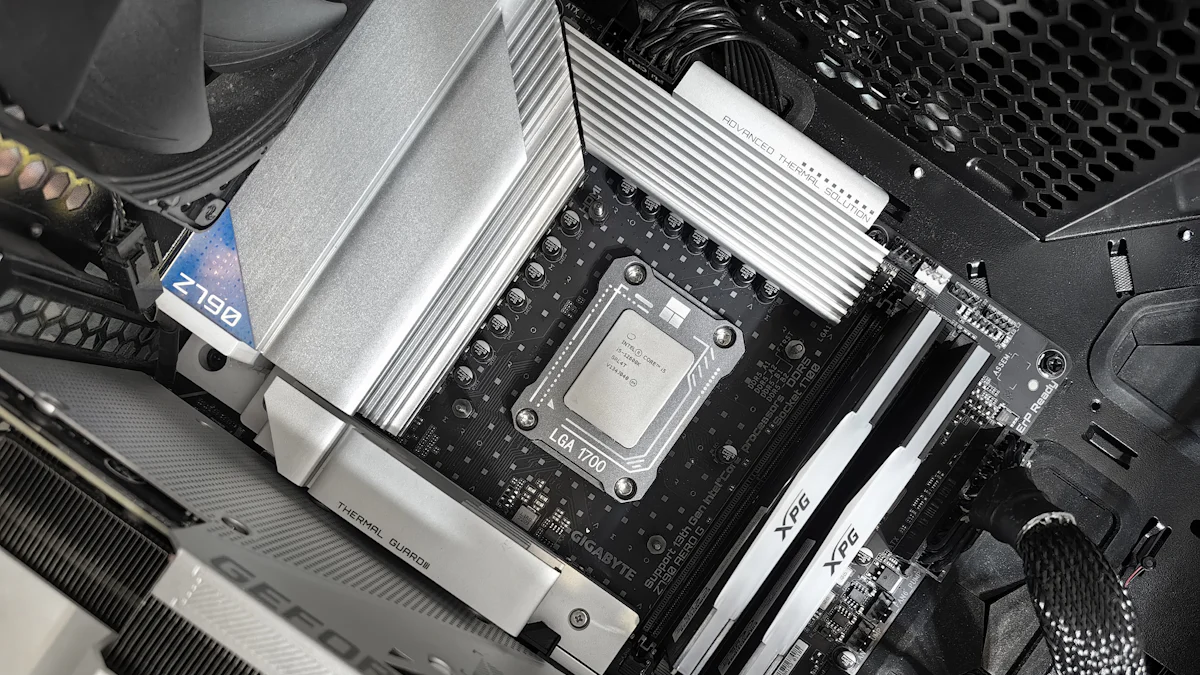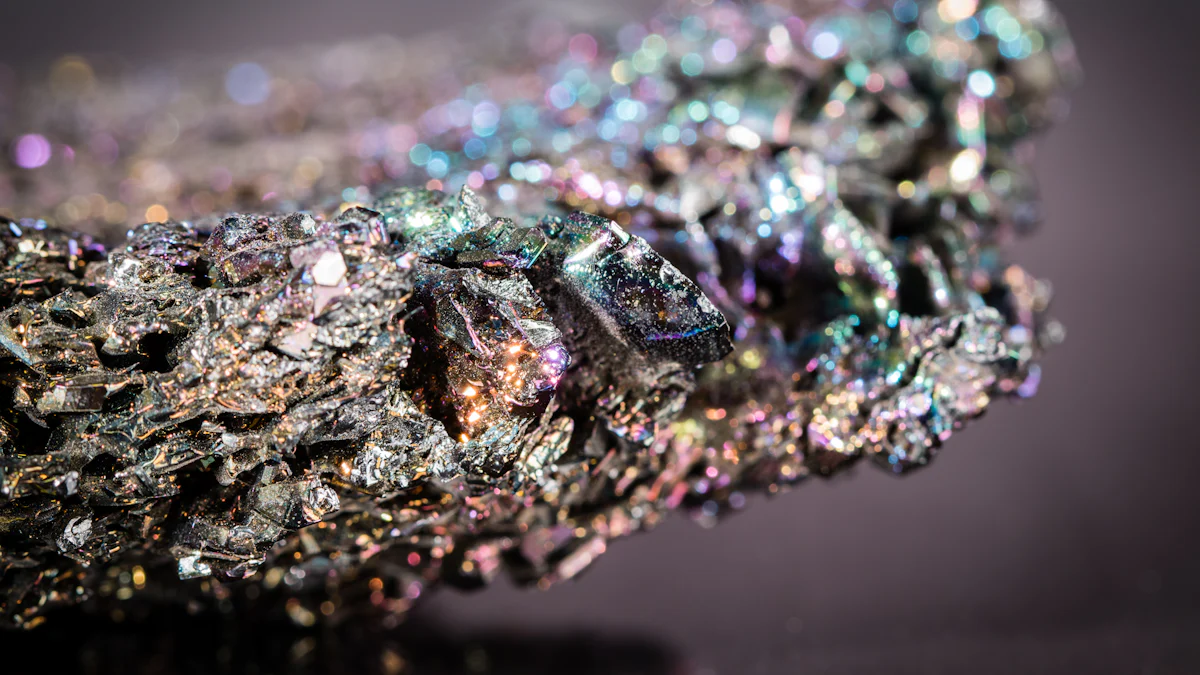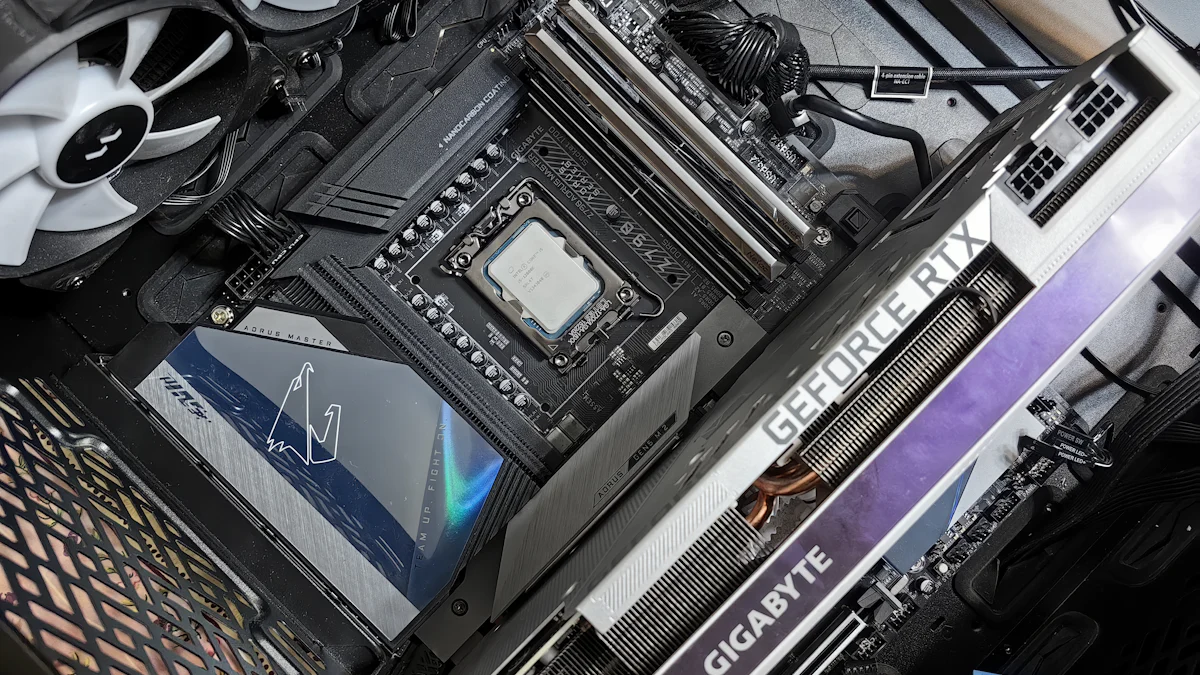
Silicon carbide coating for MOCVD processes plays a vital role in enhancing performance. Their exceptional thermal stability ensures reliable operation during high-temperature conditions, while their chemical resistance protects critical components from corrosive environments. These properties are essential for maintaining the integrity of substrates, enabling consistent thin film growth and reducing the risk of defects.
SiC coated susceptors, in particular, enhance process efficiency by providing a durable, protective surface that resists wear and contamination. This durability minimizes maintenance needs and extends the lifespan of components, leading to lower operational costs. By improving yield and ensuring uniformity in epitaxial growth, SiC coating for MOCVD has become indispensable in semiconductor manufacturing and other advanced applications.
Wichtigste Erkenntnisse
- Silicon carbide coatings help MOCVD work better by staying strong in heat and resisting chemicals.
- These coatings keep important parts safe from damage and rust, working well in hot places.
- SiC-coated parts make processes faster, lower mistakes, and improve material quality, helping make better semiconductors.
- Silicon carbide coatings are stronger than graphite and quartz, even in tough conditions.
- Their strength means less fixing is needed, saving money for companies.
- These coatings are key for new tech like green energy, electric cars, and better communication tools.
- New ideas in coating tech make silicon carbide even better for today’s needs.
- More people want silicon carbide coatings because they help make high-tech products more exact and reliable.
Understanding MOCVD and the Role of Coatings
What is MOCVD?
Metalorganic Chemical Vapor Deposition (MOCVD) is a process used to create thin films on substrates. These films are essential in manufacturing semiconductors, LEDs, and other advanced electronic devices. During the process, metalorganic compounds and reactive gases are introduced into a heated chamber. The high temperature causes these compounds to decompose, depositing a thin layer of material onto the substrate.
This method allows precise control over the thickness and composition of the film. It ensures uniformity, which is critical for producing high-performance electronic components. MOCVD is widely used in industries like optoelectronics and renewable energy due to its ability to produce high-quality materials efficiently.
Why Protective Coatings are Crucial in MOCVD
Protective coatings play a vital role in ensuring the efficiency and reliability of MOCVD processes. The extreme conditions inside the MOCVD chamber, such as high temperatures and corrosive gases, can damage unprotected components. Coatings like silicon carbide provide a robust barrier that shields these components from wear and contamination.
SiC-coated graphite susceptors in MOCVD processes highlight their importance in preparing thin films and coatings in semiconductors and optoelectronics. The SiC coating provides excellent chemical resistance and thermal stability, making it ideal for the demanding conditions of MOCVD processes. This stability ensures that the susceptor maintains its structural integrity even under high temperatures and corrosive environments, which are common in semiconductor fabrication. The use of CVD SiC coated susceptors enhances the overall efficiency of the MOCVD process. By reducing defects and improving substrate quality, these susceptors contribute to higher yields and better-performing semiconductor devices.
The choice of coating material directly impacts the performance of MOCVD equipment. Silicon carbide coating for MOCVD is preferred due to its superior thermal stability and chemical resistance. These properties ensure that susceptors maintain consistent thermal distribution, which is essential for achieving precise film thickness and composition.
Several challenges in MOCVD processes further emphasize the need for protective coatings:
| Challenge | Beschreibung |
|---|---|
| Adhesion | Low coating adhesion strength due to thermal expansion coefficient differences leads to cracking and spallation. |
| Purity | Ultra-high purity is required to prevent impurities from affecting performance at high temperatures. |
| Stability | Resistance to high temperatures and corrosive atmospheres is critical to avoid defects leading to failure. |
| Oxidation Resistance | Coatings begin to oxidize at elevated temperatures, leading to degradation and spallation. |
| Uniformity and Roughness | Inconsistent coating can cause thermal stress, increasing the risk of cracking. |
| Grain Size | Uniform grain size enhances stability; smaller grains are more prone to oxidation and corrosion. |
By addressing these challenges, silicon carbide coatings ensure the durability and efficiency of MOCVD systems. They protect critical components, reduce maintenance needs, and improve overall process reliability.
Key Benefits of Silicon Carbide Coating for MOCVD

Thermal Stability and High-Temperature Performance
Silicon carbide coatings excel in high-temperature environments, making them ideal for MOCVD applications. These coatings maintain their structural integrity even under extreme heat, ensuring reliable performance.
- SiC3 cubic silicon carbide ceramic coatings withstand temperatures up to 1600°C at atmospheric pressure.
- They perform effectively in reactive environments, including oxygen, hydrogen, and nitrogen.
- The coatings protect components from oxidation and reactions with gases at elevated temperatures.
This exceptional thermal stability ensures consistent heat distribution across the wafer. It minimizes thermal stress, reducing the risk of defects during thin film deposition. By maintaining uniformity, silicon carbide coatings enhance the quality of the final product.
Chemical Resistance and Longevity
Silicon carbide coatings offer outstanding chemical resistance, which is crucial for MOCVD processes. These coatings endure exposure to corrosive gases and harsh chemicals without degrading.
Studies show that α-SiC performs well in mildly acidic and non-oxidizing environments. In contrast, β-SiC demonstrates superior resistance to strongly alkaline and oxidizing conditions. This versatility allows Siliziumkarbid coatings to withstand a wide range of chemical environments.
In MOCVD applications, silicon carbide coatings on susceptors provide a hard, protective surface. This surface resists corrosion and degradation, even at high temperatures. By preserving the structural integrity of susceptors, these coatings ensure long-term reliability. Their durability reduces maintenance requirements, lowering operational costs over time.
Enhanced Process Efficiency and Yield
Silicon carbide coatings significantly improve the efficiency and yield of MOCVD processes. Their thermal stability and chemical resistance contribute to better substrate quality and fewer defects.
| Aspect | Benefit |
|---|---|
| Thermische Stabilität | Provides additional thermal stability and oxidation protection. |
| Defect Reduction | Reduces defects and improves substrate quality. |
| Yield Improvement | Contributes to higher yields in semiconductor fabrication. |
| Korrosionsbeständigkeit | Resists corrosion and degradation at high temperatures. |
| Heat Distribution | Facilitates efficient heat distribution across the wafer. |
These benefits translate into higher productivity and better-performing semiconductor devices. By enhancing process efficiency, silicon carbide coatings help manufacturers meet the growing demand for advanced electronic components.
Silicon carbide coating for MOCVD plays a pivotal role in achieving these outcomes. Its unique properties make it indispensable for industries that rely on precision and reliability.
How Silicon Carbide Coating for MOCVD Outperforms Alternatives
Comparison with Graphite Coatings
Graphite coatings are often used in MOCVD processes due to their excellent thermal conductivity. This property ensures uniform heat distribution, which is essential for thin-film deposition. However, graphite coatings face significant limitations in high-temperature environments. Their chemical stability decreases under extreme heat, especially in reactive atmospheres. This instability can lead to unwanted reactions, compromising the purity and consistency of the epitaxial layers.
Silicon carbide coatings, on the other hand, excel in both thermal conductivity and chemical stability. They maintain their structural integrity even at elevated temperatures, ensuring reliable performance. Unlike graphite, silicon carbide does not require additional coatings to enhance its chemical resistance. This makes it a more efficient and durable choice for MOCVD applications. By preventing unwanted reactions, silicon carbide coatings contribute to higher-quality film deposition and improved process reliability.
Comparison with Quartz Coatings
Quartz coatings are valued for their chemical purity and optical properties. These characteristics make quartz suitable for specific applications. However, quartz lacks the mechanical strength and thermal conductivity required for demanding MOCVD processes. Its lower durability under high temperatures limits its effectiveness in advanced semiconductor manufacturing.
In contrast, silicon carbide coatings offer exceptional thermal stability and conductivity. They withstand intense heat without losing structural integrity, making them ideal for high-temperature applications. Additionally, silicon carbide’s mechanical strength ensures long-lasting performance, reducing the need for frequent maintenance. These advantages make silicon carbide coatings a superior choice for industries that demand precision and reliability.
Unique Advantages of Silicon Carbide
Silicon carbide coatings possess unique properties that set them apart from alternative materials. These advantages make them indispensable for MOCVD processes:
- Exceptional thermal conductivity ensures precise temperature control during deposition.
- High chemical stability prevents unwanted reactions, maintaining the purity of deposited films.
- Strong mechanical strength resists wear and tear in harsh environments.
- Reliable performance under extreme conditions enhances process efficiency.
- Unmatched durability and corrosion resistance extend the lifespan of critical components.
Silicon carbide coatings also minimize thermal expansion mismatches, reducing the risk of defects. This ensures uniform heat distribution, which improves the quality of epitaxial layers. By combining these properties, silicon carbide coatings deliver superior performance in MOCVD applications. Their ability to enhance yield and reduce maintenance costs makes them the preferred choice for modern industries.
Applications of Silicon Carbide Coating for MOCVD

Semiconductor Manufacturing
Silicon carbide coatings play a critical role in semiconductor manufacturing. These coatings are essential in MOCVD processes, where they protect graphite susceptors from the harsh conditions inside deposition chambers. The extreme temperatures and reactive gases in these environments can degrade uncoated components. Silicon carbide coatings provide the necessary thermal stability and chemical resistance to ensure consistent thin film growth.
- SiC-coated graphite susceptors enhance thermal stability and oxidation protection. This stability is crucial for maintaining uniformity during thin film deposition.
- The coatings resist chemical corrosion, reducing the risk of contamination and defects.
- By improving substrate quality, silicon carbide coatings contribute to higher yields in semiconductor fabrication.
These benefits make silicon carbide coatings indispensable for producing high-performance semiconductors. Their ability to withstand demanding conditions ensures reliable and efficient manufacturing processes.
Renewable Energy Technologies
The renewable energy sector relies on advanced materials to improve efficiency and durability. Silicon carbide coatings support this goal by enhancing the performance of components used in MOCVD-Verfahren. These processes are vital for creating thin films used in solar cells and other renewable energy technologies.
Silicon carbide coatings provide excellent thermal conductivity, which ensures precise temperature control during deposition. This precision improves the quality of thin films, leading to more efficient solar cells. Additionally, the coatings resist wear and corrosion, extending the lifespan of critical components. By reducing maintenance needs, silicon carbide coatings lower operational costs for renewable energy manufacturers.
The demand for renewable energy continues to grow, driving the need for reliable materials like silicon carbide coatings. Their unique properties make them a valuable asset in the transition to cleaner energy sources.
Emerging High-Tech Applications
Emerging technologies are creating new opportunities for silicon carbide coatings in MOCVD processes. Industries such as electric vehicles (EVs), 5G wireless communications, and advanced optoelectronics rely on high-quality thin films. Silicon carbide coatings ensure the precision and reliability needed for these applications.
- Electric vehicles benefit from silicon carbide coatings in the production of power electronics. These coatings improve the efficiency and durability of components, supporting the development of EV technology.
- 5G wireless communications require advanced semiconductors with precise thin films. Silicon carbide coatings enhance the quality of these films, enabling faster and more reliable networks.
- Optoelectronic devices, such as LEDs and laser diodes, depend on MOCVD processes for thin film deposition. Silicon carbide coatings ensure consistent performance, reducing defects and improving yield.
The versatility of silicon carbide coatings makes them a key material for high-tech industries. Their ability to meet the demands of emerging applications highlights their importance in modern manufacturing.
The Future of Silicon Carbide Coating for MOCVD
Innovationen in der Beschichtungstechnologie
Recent advancements in coating technologies are transforming the performance of silicon carbide coatings for MOCVD. These innovations focus on improving thermal stability, chemical resistance, and overall efficiency. Researchers are exploring new methods to enhance the properties of silicon carbide coatings, ensuring they meet the growing demands of modern industries.
| Innovation Type | Beschreibung |
|---|---|
| Thermal Stability and Oxidation Resistance | SiC coatings provide additional thermal stability and oxidation protection in high-temperature environments, crucial for thin film growth consistency. |
| Material Interface and Surface Properties Control | Adjusting SiC coating properties improves interactions between the film and substrate, enhancing growth modes and interface quality. |
| Reducing Impurity Contamination | High purity of SiC coatings minimizes impurity contamination from substrates, ensuring high purity in epitaxial films. |
| Production Process Improvements | Research focuses on enhancing coating purity and uniformity, increasing quality and lifespan while reducing costs. |
| New Coating Technologies | Exploration of TaC coatings on graphite susceptors to improve thermal conductivity and corrosion resistance. |
These advancements ensure that silicon carbide coatings remain reliable under extreme conditions. For example, improving surface properties enhances the interaction between the coating and the substrate, leading to better film growth. Additionally, reducing impurity contamination ensures the purity of epitaxial films, which is critical for semiconductor manufacturing. By focusing on these areas, researchers are paving the way for more efficient and durable coatings.
Growing Demand in Advanced Industries
The demand for Siliziumkarbid-Beschichtungen in MOCVD processes is rapidly increasing across various industries. This growth is driven by the need for high-performance materials in emerging technologies. Industries such as automotive, aerospace, telecommunications, and renewable energy are leading this demand.
- Electric vehicles require advanced semiconductor devices, which rely on silicon carbide coatings for improved efficiency and durability.
- Renewable energy systems use these coatings to enhance power handling capabilities, making them essential for solar cell production.
- The rollout of 5G wireless communications depends on reliable semiconductor devices, further boosting the market for silicon carbide coatings.
- Aerospace applications leverage the thermal stability of silicon carbide coatings for high-performance environments.
- Consumer electronics demand energy-efficient devices, which benefit from the precision and reliability of silicon carbide coatings.
Die automotive sector, in particular, is expanding its use of silicon carbide-based technologies due to the rise of electric vehicles. Similarly, telecommunications and consumer electronics are driving the need for advanced semiconductor technologies. These industries highlight the versatility and importance of silicon carbide coatings in modern manufacturing.
As industries continue to innovate, the role of silicon carbide coating for MOCVD will become even more critical. Its unique properties make it indispensable for applications that require precision, reliability, and durability.
Silicon carbide coatings ensure the success of MOCVD processes by delivering unmatched thermal stability and chemical resistance. Their durability reduces maintenance needs and extends component lifespans, resulting in significant cost savings. Industries benefit from their ability to enhance efficiency and yield, making them a preferred choice over alternatives.
Global trends highlight the growing importance of silicon carbide coating for MOCVD. Rapid expansion in Asia Pacific and advancements in North America drive demand, while Europe focuses on sustainability. As industries innovate, silicon carbide coatings will remain essential for achieving precision and reliability.
FAQ
What makes silicon carbide coatings ideal for MOCVD processes?
Silicon carbide coatings excel due to their thermal stability, chemical resistance, and durability. These properties ensure reliable performance in high-temperature, corrosive environments. They protect components, reduce maintenance, and improve process efficiency, making them indispensable for MOCVD applications.
How do silicon carbide coatings improve semiconductor manufacturing?
Silicon carbide coatings enhance thermal stability and resist chemical corrosion. This ensures consistent thin film deposition, reduces defects, and improves substrate quality. These benefits lead to higher yields and better-performing semiconductor devices, making them essential for advanced manufacturing.
Are silicon carbide coatings cost-effective?
Yes, silicon carbide coatings reduce maintenance needs and extend component lifespans. Their durability minimizes downtime and replacement costs. By improving process efficiency and yield, they offer long-term cost savings for industries relying on MOCVD processes.
Can silicon carbide coatings withstand extreme temperatures?
Silicon carbide coatings perform exceptionally well under extreme heat. They maintain structural integrity at temperatures up to 1600°C. This ensures consistent heat distribution and reliable performance during high-temperature MOCVD processes.
What industries benefit from silicon carbide coatings?
Industries like semiconductor manufacturing, renewable energy, and advanced electronics benefit from silicon carbide coatings. They are also crucial for emerging technologies, including electric vehicles, 5G communications, and optoelectronics, due to their precision and reliability.
How do silicon carbide coatings compare to graphite coatings?
Silicon carbide coatings outperform graphite by offering superior chemical stability and thermal conductivity. They resist degradation in reactive environments, ensuring reliable performance. Unlike graphite, silicon carbide does not require additional coatings, making it a more durable and efficient choice.
Why are silicon carbide coatings important for renewable energy?
Silicon carbide coatings improve the efficiency and durability of components used in solar cells and other renewable technologies. They ensure precise temperature control during deposition, enhance thin film quality, and reduce maintenance needs, supporting the transition to cleaner energy sources.
What advancements are being made in silicon carbide coatings?
Innovations focus on improving thermal stability, chemical resistance, and coating purity. Researchers are enhancing surface properties and reducing impurity contamination. These advancements ensure silicon carbide coatings meet the growing demands of modern industries.